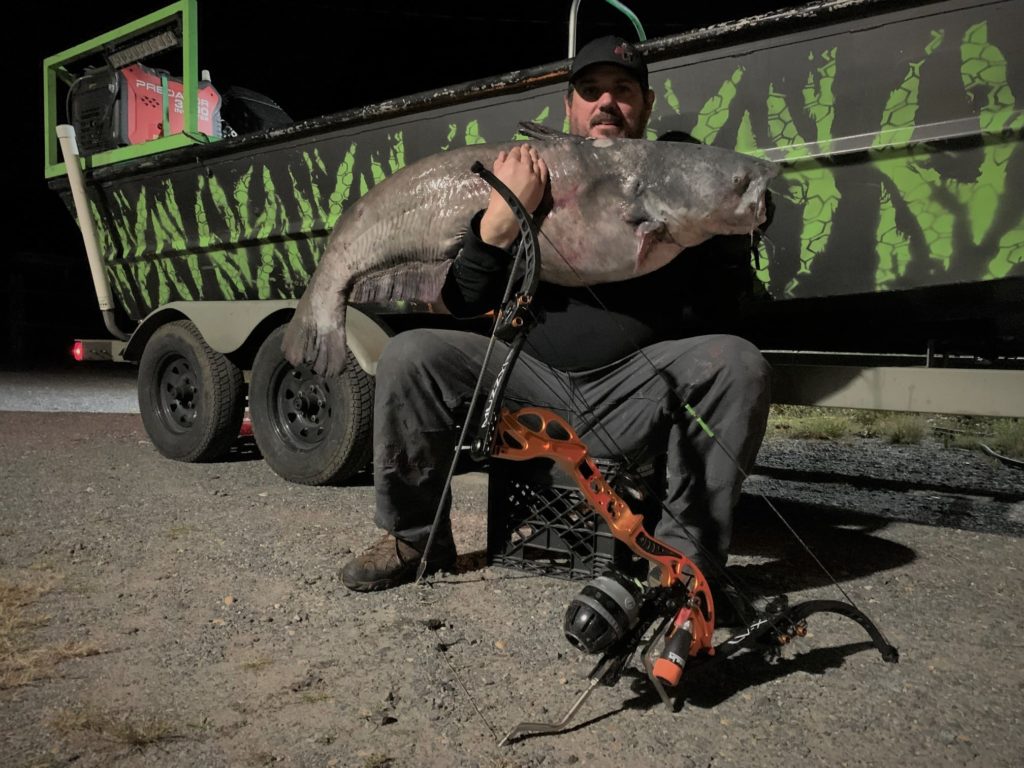It is not as popular as target archery or bowhunting, and it is not widely practiced by rod and reel anglers, either. But bowfishing is popular throughout the United States, including in the Bay watershed. Records are kept of noteworthy captures, and a colossal new blue catfish record has just been approved in Virginia.
William Bates, of Maryland, was bowfishing on Oct. 1, 2021 in Occoquon Bay, Fairfax County, Va. when he spotted and arrowed a monster blue. The fish was 47 inches long, with a girth of 32 inches. It weighed 62 pounds, 4 ounces. The previous state record had been just over 55 pounds. Bates’ fish was only 4 inches short of the world record 52-inch blue cat archery record. Bates’ record was approved by DWR on Jan. 6, 2022.
Bows have been used as weapons since prehistoric times. Our ancestors used them for offense, defense, hunting, and fishing. Bows were the primary long-range weapon until gunpowder was invented. It was British aristocrats that began using bows in sports. For bowfishing, you only need a bow of 30 pounds pull or more. You will need a reel to hold your line, and of course an arrow. You can spend anywhere from a few hundred dollars to four figures for a setup. You can bowfish from the shore, but having a boat or kayak improves your odds.
Serious freshwater bowfishers go out at night. Catfish are more active at night, and will move into shallow waters to hunt. Bowfishers cruise the shore and shallows with powerful lights beaming into the water. Some specially rigged boats have a row of lights up and down each side, as well as off the bow. Think stadium lighting packed into a small boat. Some carry gas generators to power the lights!
The fishing is up close and quick. Very quick. The fish are often spotted the same instant they are spooked and swimming away. It happens so quickly that there is barely time to draw the bow and acquire the target. Bow fishers often keep the bow drawn and ready. Aiming is somewhat instinctual due to the split-second timing involved. Shooters also have to adjust for refraction. Because of the way light bends at the water’s surface, the fish are usually deeper than they appear. It takes practice. Competent bowfishers possess excellent archery skills.
Clint Morgenson, a Regional Fisheries Manager with the Virginia Division of Wildlife Resources (DWR), says “DWR has not conducted formal surveys about bowfishing, but the number of participants in the sport seems to be growing. Some converts are bow hunters who took on fishing to improve their archery skills. There are guides who will take out beginners, and can teach the proper techniques, including safety.”
Travis Stauch is one of those guides who takes beginners. Stauch, who operates Ramrod Bowfishing in Northern Virginia, agrees that bowfishing is increasing in popularity. “There must be at least three times as many bowfishers on the Potomac now compared to just a few years ago,” he said. “Our beginners usually have success their first night. Teaching people to aim low, because of the refraction, is the biggest challenge.”
In Virginia, regulations allow the taking of common carp, grass carp, snakehead, and gar with a bow, day or night. Catfish and bowfin can be taken by bow in tidal waters below fall lines. The creel limits for blue catfish are generous, considering their invasive status. There are no limits in Occoquon Bay, where Bates landed his record-breaker.
Blue catfish are native to the Mississippi, Missouri, Ohio, and Rio Grande river basins. They have been stocked in about 20 states. They were intentionally placed in select eastern fresh water river systems for sport. Unknown to the stockers, the fish have a high tolerance for salinity. They traveled out of some rivers, through salty water, and into adjacent (non-stocked) watersheds. On the Chesapeake Bay, blue cats are considered an invasive species. They don’t just scavenge along the bottom. Blue cats are predators and will prowl the water column, eating whatever they catch. They target fin fish, including shad. Blue catfish are believed to be one of the impediments to American shad recovery in the James River. Now, there is one fewer of this invasive species on the Bay.
-Kendall Osborne



